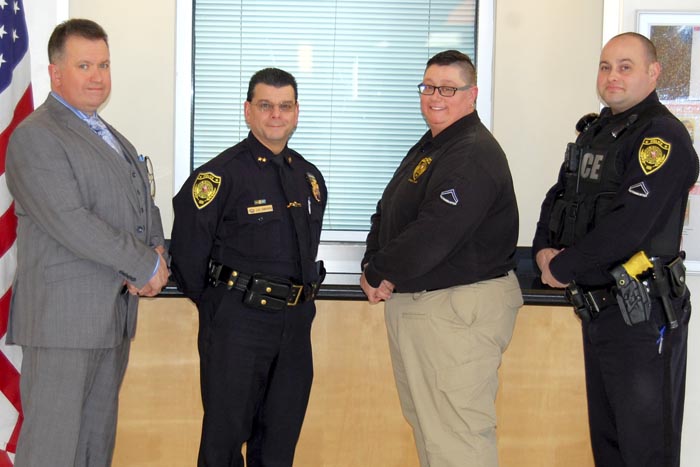
From left, Saugerties police Capt. Steven Filak, Chief Joe Sinagra, Dispatcher Vera White and Officer David Stoutenburg. (Photo by Christina Coulter)
Twenty-seven area police personnel from nine departments graduated from a Crisis Intervention Training (CIT) session, conducted in 40 hours over a week-long period, on Friday, Feb. 1. The sessions took place at the Ulster County Law Enforcement Center and were taught entirely by local police officers and healthcare professionals trained in Albany last year to be CIT instructors. Previous CIT classes have been taught in Albany by ferried-in instructors from elsewhere in the state.
Graduates included members of the Ulster County Sheriff’s Office; the New York City Department of Environmental Protection Police; the Schenectady County Sheriff’s Office; officers from Saugerties, Shandaken, the Town of Ulster, Rosendale and New Paltz police departments; and members of the SUNY Ulster Office of Public Safety. The program’s instructors were Kingston Detective Thierry Croizer, Saugerties Police Captain Steven Filak, New Paltz officer Phil Kraus, Patricia Tuber of New York City’s Mobile Crisis Team Services and Chris Dennehy of Step One NY. The training was organized by People USA, a nonprofit organization based in Kingston that provides behavioral healthcare to those with mental illness.
“It’s designed for officer safety and public safety, to make interactions safer for everyone involved,” said Croizer of the training’s core aims.” We know as administrators that crisis intervention training works to lower arrest rates … but the biggest plus for us is liability prevention.”
Graduating Saugerties officers include Police Chief Joe Sinagra, Officer David Stoutenburg and Dispatcher Vera White.
“A lot of it is taking information back to your agency,” said White. “One of the biggest things is information-sharing, trying to fit [that information] where it’s needs to be. [Mentally ill people interacting with law enforcement] talk to the dispatcher, they talk to the responding officer and they talk to hospital staff. It’s about finding the right place and piece for that person, where they need to be — every cog in that wheel is trying to find it collectively together. It’s a different piece in every puzzle we get.”
Fourteen of 35 total Saugerties police personnel have now received CIT training; Sinagra is the first police chief in the county, he said, to graduate from the program.
“If law enforcement officers can understand and identify mental illness, we will drastically reduce the amount of physical force used,” said Sinagra. “As opposed to assuming that someone is being defiant, we have insight to see whether or not there’s an underlying mental illness or someone on drugs. Because our mental health system is broken in this country, it’s imperative that law enforcement officers to receive this training.”
Sinagra said that the department aims to certify all its officers in CIT — “I don’t want us to just take [some members of the] department and certify them — we don’t want to roll the dice.”
Croizer said of all of the special training and certification programs offered to police in the county, CIT training is “the most underrepresented.” He said that through the course of the training, officers are faced with hypothetical situations and instructed on how to properly navigate them — vignettes including suicidal subjects, people with schizophrenia or people with developmental disabilities.
Among subjects covered in the curriculum (which, according to Dutchess and Putnam program director Steve Miccio, hasn’t changed much since the first training took place in 1987) are the difference between mental illness and intellectual disabilities, common myths about mental illness, a review of resources available to mentally ill and emotionally distraught subjects that officers can divert them to, non-abrasive body language, scripts to employ in trying situations and breathing exercises that cops can share with those they encounter.
According to the course literature, 61 percent of Americans think that “people with schizophrenia are a danger to others”; however, individuals with serious mental illness are only responsible for 3.5 percent of violent acts recorded nationally but make up 25 percent of those victimized. Seventy percent of youths in juvenile detention and 17 percent of inmates at booking nationally suffer from mental illnesses — staggering numbers as mental illness affects 4 percent of the total population.


Congratulations to Saugerties Township Chief of Police Joe Sinagra, the only Town Police Chief in Ulster County, for obtaining this certification, and to Officer David Stoutenburg & Dispatcher Vera White also……!
Chief Sinagras aim to see that the entire force be certified is commendable…….!
His efforts towards continuing education for himself and his department shows a man of vision.
The Town of Saugerties should be proud to have such a person leading it’s Law Enforcement Department
BAD PR PHOTO
is the Yellow Taser shown on officer (4th right) part of the training????
When confronting mentally ill person we want to avoid escalation, showing person Taser is not productive negation technique.
We must think carefully especially, before public photo, wrong image can send wrong message/impression.
Bad PR photo.